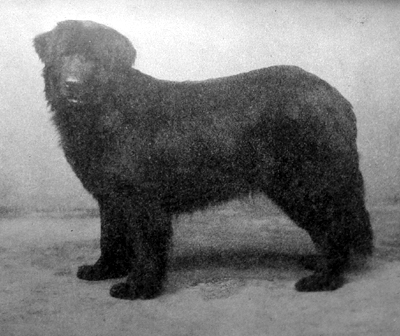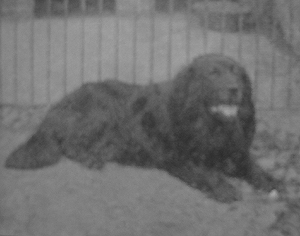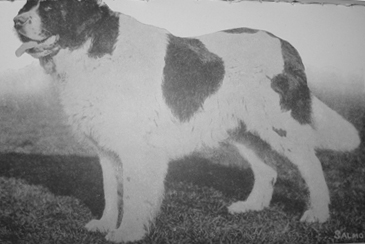These huge water-dogs have long held a reputation for saving lives at sea — a reputation — though probably over-estimated — that has not been gained without many of these noble animals having performed some significant service towards those placed in perilous positions.
Judging from the literature upon the subject, it is evident that Newfoundlands were widely distributed as early as 1803, thus taking us back over a century. The original Newfoundland was, no doubt, a smaller dog than the present breed, with an indifferent coat, colour, and other defective features.
The so-called "Landseer" Newfoundland — faithfully depicted by this genius — taking his name from the latter, is black and white, but other Newfoundlands are altogether black, unless it be that they have trifling white patches on chest and feet.
Liver-coloured specimens of the breed are not unknown, though this colour is undesirable, therefore not encouraged.
Colour. The colour most sought after is raven black, and in the author's opinion there should be no white hairs, but white on feet or chest are not objected to by experts.
Like almost every other variety of black dog, the Newfoundland has frequently a rusty tinge, seen especially in a strong light.
This bronze tinge is not considered objectionable. When a Newfoundland has white tips on feet and tail, and a small patch of white on chest, he or she must compete in the class for Blacks. Given a black of equal merit without these few white hairs, the author would prefer it, and thinks that many others would do the same.
Black and white, and bronze, are other colours — chiefly the former — most encouraged by breeders of typical Newfoundlands. Regularity and beauty of markings are of great importance, so many being indifferently marked. The markings, but not the coat, upon the dog depicted by Landseer may be taken as fairly typical.
Height (average). Dogs (measured at shoulder), 27 inches; bitches (measured at shoulder), 24 to 26 inches, with proportionate symmetry.
Weight. Dogs, 85 to 100 lb.; bitches, 75 to 85 lb.
Temperament. Should be sweet-tempered and companionable. Many half-bred Newfoundlands are vicious, but this in no way interferes with the disposition of the genuine article.
Head, Ears and Eyes. The head is best described as massive, the skull being broad and flat, and the muzzle short, clean and squarish in outline. Benignity of expression is an essential to beauty in this region. Ears ought to lie close to head, be small, set well back and free from fringe. Eyes, small, set well apart, deeply-set-in orbits and dark brown. There must be none of the Bloodhound haw showing.
Chest and Fore-quarters. Chest, broad and deep, without frill. Shoulders and arms well clothed with muscle, and legs straight, big-boned and feathered all the way down. Neck short, but full and round. Feet, full, and curved straight out.
Ribs, Back and Loins. Ribs well rounded, broad; and deep in front, likewise back ribs deep, a tucked-up belly being objectionable, so many Newfoundlands are faulty in this region. Fulness is desirable. Back, of medium length, broad, strong and fairly level, rising a little as the loins are reached.
Hind-quarters, Legs and Tail. Powerful hindquarters are a sine quâ non. Thighs, broad. Hocks strong, but turned neither in nor out. Cow-hocks objectionable. Dew-claws (single or double) equally so. When puppies are born they should be examined for the presence of dew-claws, and if present, removed at once. Tail must not curl over the back. When dog is at rest, it should fall down below the level of the hocks, but under excitement the tail ought to be carried straight out with a trifling curve at the tip.
Coat. Not too fine in texture, but not coarse. Must be flat and heavy.
Faults. Bad markings, dew-claws, Hound-carriage of tail, legginess and want of symmetry, curly coat, cow-hocks, slack loins, narrowness of skull, too much sign of stop, etc., etc., and Bloodhound eyes.
General Appearance. A symmetrically - built, powerful, long, flat-coated, massive-headed, black or parti-coloured dog, in size a trifle less than the smallest Shetland pony, having an intelligent expression, and a fondness for swimming.
Club. Newfoundland, particulars relating thereto being as follows:
"1. Name and Object of the Club"
That this club be called 'The Newfoundland Club.' That its object be to promote the breeding of pure Newfoundlands, by endeavouring to make the qualities and type of the breed more definitely known.
"To define precisely, and publish a description of the true type of the breed, and to urge the adoption of such type upon breeders, judges, and dog-show committees, as the only recognised and unvarying standard by which Newfoundlands are to be judged, and which may in future be uniformly accepted as the sole standard of excellence in breeding, and in awarding prizes of merit to Newfoundlands.
"2. Establishment and Constitution
"That the club consist of an unlimited number of members, whose names and addresses shall be entered in a book kept for that purpose by the hon. secretary, which book shall be open for the inspection of members at all reasonable times. That any reputable person, favourable to the objects of the club, shall be eligible for admission as a member by the committee, and that each candidate for admission shall be proposed by one member of the club, and seconded by another. The name of no new candidate for admission as a member to be submitted to the committee until he has signed the printed standard adopted by the club, and has furnished the secretary with the names and addresses of two respectable persons, as references if required.
"3. Subscription
"That the entrance fee be five shillings and the annual subscription one guinea. That the annual subscription be due on 1st January in each year, and that any member being more than twelve months in arrears of any kind to the club shall cease to be a member of the club, and shall be ineligible for re-election until all arrears are paid, and that no member shall be qualified to compete for prizes given by the club unless all arrears due to the club be paid up prior to the opening of the show at which such prizes are given.
"4. Prizes
"That all prizes given by the club be confined to members only.
"5. Management
"That the affairs of the club shall be conducted by a president and two vice-presidents, hon. secretary and hon. treasurer, and a committee of eight and any such other officers the committee may deem advisable to appoint. Officers to be ex-officio members of the committee.
"The officers and members of the committee shall retire annually, but shall be eligible for re-election by the club.
"Officers and members of the committee shall be elected in the following manner
"The hon. secretary shall send voting papers in the third week in November to every member of the club, who shall be entitled to one vote.
"The votes to be recorded by marking the names of any eight (or less) on the list of candidates to serve on the committee and by marking one name among the candidates for the office of president, two vice-presidents, hon. secretary, hon. treasurer, and auditor.
"The list must be returned to the hon. secretary during the second week in December, in a closed envelope supplied for that purpose by the secretary, and bearing on the outside the words,'Newfoundland Club Voting Paper.'
"The scrutiny shall be made by the secretary at a committee meeting, and signed voting papers shall be actually void.
"The voting papers shall be handed to the committee in their unopened envelopes, and the names of the eight members receiving the highest number of votes, together with the names of the officers, shall be printed and sent to each member of the club as soon as possible after the meeting.
"6. Annual Report and Balance-Sheet
"That an annual report, together with the rules of the club, the names and addresses of the members and officers, and the annual statement of accounts (duly audited), be drawn up by the committee and sent to every member of the club not later than 31st March in each year.
"7. Vacancy on Committee
"In the event of a vacancy occurring for an officer or member of committee from any cause during the year, the vacancy shall be filled by the committee by co-optation.
"8. Powers of Committee
"The committee shall have sole power to decide in disputed matters (such decision to be without appeal) and to expel any member considered by them guilty of dishonourable conduct or a breach of rules. Upon such expulsion the member so expelled shall not be entitled to recover any portion of his subscription, or have any claim against the club. That the committee shall have power to deal with any question relating to the management of the club not provided for by the rules.
"9. Honorary Treasurer
"The honorary treasurer will be held responsible for all funds entrusted to him by the committee or honorary secretary. He will make payments to the committee or honorary secretary as required, out of the funds at his disposal, and will furnish a statement of his accounts at such times as may be necessary.
"10. Meetings and Minutes
"That there shall be a meeting of the committee as often as may be deemed necessary by them; but there shall be a general meeting of the members of the club held at least once every year, and oftener when deemed advisable. A special general meeting shall also be called on requisition, in writing, to the secretary signed by not less than six members. A fortnight's notice (in writing) shall be given or sent by post by the secretary to all members of the club, previous to either a general or special general meeting. That at all meetings the minutes of the preceding meetings shall be read at the commencement, and, if approved, shall be confirmed. Three shall form a quorum for a committee and five for a general meeting.
"That all officers of the club be honorary, and that no member be allowed to make the club a means of private speculation or trade, or to derive money profit through it.
"11. Alteration of Rules
"That all new rules, or alteration of existing rules, or the reversal of any former act or decision, be made at a general meeting. That such new rules, or alteration of existing rules, or the reversal of any former act or decision, be not adopted unless they receive the sanction of at least two-thirds of the members voting. That it shall be competent for members who do not attend any such meeting to record previously, by letter to the secretary, their votes; such letters to be read at the meeting, and taken as votes.

Black Newfoundland Dog
"12. Judge
"That ten ladies and gentlemen, members of the club, be annually elected by members to act as judges of Newfoundlands.
"That a list of ladies and gentlemen willing so to act be sent to every member of the club, and the selection to be made as provided by Rule 5 for the selection of the committee.
"The judge shall not exhibit for competition or be interested directly or indirectly in the show at which he officiates.
"Any number of ladies and gentlemen who are members of the club may be elected annually as judges of Newfoundlands, provided that no one may be considered so elected who does not receive votes from at least one-third of the number of members returning voting papers.
"The elections to be made annually as provided by Rule 5, in conjunction with the election of officers and committee.
"The committee shall have power to fill vacancies during the year, and to elect additional judges if considered desirable in the interests of the club.
"The committee may also at their discretion elect ladies or gentlemen, who are not members of the club, to be honorary judges.
"13. Mode of Judging and Prizes
"That the club judges shall award prizes impartially, according to the order in which dogs approach perfection in the type, formation, and proportions fixed by the club as the true standard of excellence. That no prize be awarded by the club to any show not held under Kennel Club rules or license.
"14. Expenses
"That all expenses properly incurred by the committee, for or on behalf of the club, shall be defrayed out of the funds of the club alone, and no individual member shall be deemed to incur any responsibility in respect of the same.
"15. Duties
"That every member strive to promote honourable dealings in canine matters, and bring to the notice of the club committee any irregularity at dog shows I affecting the club; also that every member, when able, shall furnish reports of shows, and any other information likely to prove useful to breeders, judges, etc., and to promote the success of the club.
"16. Resignation
"That it shall be competent for any member to withdraw from the club on giving or sending notice of his intention, in writing, to the secretary at least two months before the expiration of the current year; but any member leaving the club shall not be entitled to receive back any money he may have paid to or on account of the club during his membership, or have any claim against the club.
"The foregoing rules were adopted at a general meeting held at the Crystal Palace, in October 1892."
"DESCRIPTION OF THE NEWFOUNDLAND DOG
"Symmetry and General Appearance. The dog should impress the eye with strength and great activity. He should move freely on his legs with the body swung loosely between them, so that a slight roll in gait should not be objectionable; but at the same time a weak or hollow back, slackness of the loins or cow-hocks should be a decided fault.
"Head. Should be broad and massive, flat on the skull, the occipital bone well developed, there should be no decided stop, the muzzle short, clean cut, rather square in shape, and covered with short fine hair.
"Coat. Should be flat and dense, of a rather coarse texture, oily, and capable of resisting the water. If brushed the wrong way, it should fall back into its place naturally.
"Body. Should be well ribbed up with a broad back. Neck, strong, well set on to the shoulders and back, with strong muscular loins.
"Fore-legs. Should be perfectly straight, well covered with muscle, elbows in, let down, and feathered all down.
"Hind-quarters and Legs. Should be very strong; the legs should have great freedom of action, and a little feather. Slackness of loins and cow-hocks are a great defect; dew-claws are objectionable, and should feathered be removed. [sic]
"Chest. Ought to be deep, fairly broad and well covered with hair, but not to such an extent as to form a frill.
"Bone. Massive throughout, but not to give a heavy inactive appearance.
"Feet. Should be large and well shaped. Splayed, or turned-out feet are objectionable.
"Tail. Should be of moderate length, reaching down a little below the hocks; it should be of fair thickness, and well covered with long hair, but not to form a flag. When the dog is standing still and not excited, it should hang downwards with a slight curve at the end; but when the dog is in motion, it ought to be carried a trifle up, and when excited, straight out, with a slight curve at the end. A tail with a kink in it, or one curled over the back, is objectionable.
"Ears Should be small, set well back, square with the skull, lie close to the head, and covered with short hair, but no fringe.
"Eyes. Should be small, of a dark brown colour, rather deeply set, but not showing any haw, and they ought to be rather widely apart.
"Colour. Jet black. A slight tinge of bronze, or a splash of white on chest and toes is not objectionable.
"Height and Weight. Size and weight are very desirable, so long as symmetry
is maintained. A fair average height at the shoulders is 27 inches for a dog and
25 inches for a bitch, with an average weight of —
"Dogs, 140 to 150lbs; bitches, 110 to 120 lbs.
"Other than Black. Should in all respects follow the black except in colour, which may be almost any, so long as it disqualifies for the Black class, but the
colours most to be encouraged are black and white and bronze. Beauty in markings to be taken greatly into consideration.
ADDENDA
Dogs that have been entered in Black classes at shows held under Kennel
Club Rules, where classes are provided for dogs other than black, shall not be qualified to compete in Other than Black classes in future.
Black dogs that have only white toes and white breasts and white tip to tail
are to be exhibited in the classes provided for Black.
Passed at a general meeting held at the Crystal Palace, 27th October, 1891.
SCALE OF POINTS
Head, 34 points:
Shape of Skull..................................... 8
Ears..................................................... 10
Eyes.................................................... 8
Muzzle.................................................. 8
Body, 66 points:
Neck.................................................... 4
Chest................................................... 6
Shoulders............................................. 4
Loin and Back.................................... 12
Hindquarters and Tail......................... 10
Legs and Feet...................................... 10
Coat.................................................... 12
Size, Height, and General Appearance.. 8
____
Total points in all................... 100
(pp. 48 -67)



